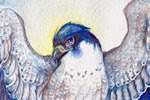Apologies for the lack of updates lately, however for the past week I've been concentrating on the writing portion of my thesis so that I would have a first draft done in time for editing. With that sent off, I've continued work on the painting of the peregrine falcon as used in falconry in the United States.
I am well aware that the peregrine is used worldwide in falconry, and not only in the United States. However, the purpose of this painting is not to exclude any region, but rather to focus on falconry in a specific area of the world, and I chose a bird that I feel represents a widely-used longwing species in the U.S.
It's only fair to point out the efforts of falconers and a variety of societies in the United States for peregrine falcon reintroduction after the widespread damage done by the pesticide DDT in the mid-20th century. The Peregrine Fund, which was started in 1970, was one of the foremost organizations in the United States to rebuild peregrine populations nationwide. To this day it remains an active force in raptor conservation. Other organizations which focus on raptor conservation include the North American Falconer's Association and a number of individual rehabilitation and education centers.
According to Candace Savage in her book
Peregrine Falcons, the peregrine falcon population in the west coast region of the United States went from over 1,400 pairs in the 1940s to just over 100 pairs in the mid-1970s (an in-detail graph of worldwide populations exists on page 54, in case you have the book). In the late 1980s, the population on the west coast rose to just over 400 pairs. Today, the population of the peregrine falcon is doing well, thanks to the banning of DDT and these conservation efforts.
That said, here is the painting in progress:

And a detail of the falcon so far:

There peregrine falcon is also known as the 'duck hawk,' for what should be an apparent reason. When choosing a duck species, I wanted to show mallards since that is one of the most well-recognized duck species in the United States. While I know the jesses probably wouldn't be flying so wildly as that, I wanted to put a bit of movement behind the stiff, angular falcon to compliment the curving ducks.
The markings of peregrines are so beautiful, and while challenging to paint, it's rewarding when it starts to come out right.
UPDATE May 9, 2009 2:48 AM Here's a bit more progress:

Detail of the falcon:


